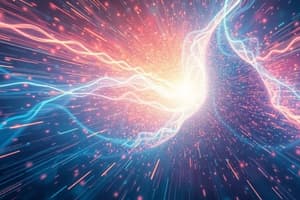Podcast
Questions and Answers
What does the distance between atoms influence in the states of matter?
What does the distance between atoms influence in the states of matter?
- The color of the substance
- The motion of atoms (correct)
- The temperature of the substance
- The weight of the atoms
Which of the following substances undergoes sublimation?
Which of the following substances undergoes sublimation?
- Sugar
- Water
- Dry ice (correct)
- Ice
What is the main characteristic of sublimation?
What is the main characteristic of sublimation?
- It requires cooling to occur
- It cannot be reversed
- It converts solid directly into liquid
- It involves the formation of a gas without a liquid phase (correct)
In the example given, what happens to ammonium chloride when heated?
In the example given, what happens to ammonium chloride when heated?
The term 'sublimation' suggests that there is a process occurring without which phase?
The term 'sublimation' suggests that there is a process occurring without which phase?
What is indicated by the notation 'Sub li' mation?
What is indicated by the notation 'Sub li' mation?
What happens to the particles of a solid during sublimation?
What happens to the particles of a solid during sublimation?
Flashcards are hidden until you start studying
Study Notes
States of Matter
- Three states of matter: solid, liquid, and gas, each exhibiting unique particle motion.
- Particle motion is influenced by distance between atoms; increased distance allows more space for greater motion.
Sublimation
- Sublimation refers to the direct transition from solid to vapor without passing through the liquid state.
- Common substances that undergo sublimation include dry ice, naphthalene balls (mothballs), iodine, and ammonium chloride.
- Example process: Heating camphor or ammonium chloride in a covered dish results in vaporization, with vapors condensing back into solid form when they contact cooler surfaces.
- Mnemonic for sublimation: "Subtract Liquid phase" emphasizes that sublimation skips the liquid state completely.
Studying That Suits You
Use AI to generate personalized quizzes and flashcards to suit your learning preferences.




